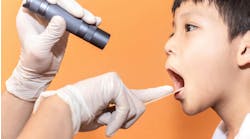The American Dental Association (ADA) celebrates Children’s Dental Health Month in February. What started in 1941 as a single day morphed into an entire month by 1981. And judging by the stats, that might not be enough. Data from the CDC shows from 2011-2016, 23% of children aged 2-5 had cavities.1 The Care Quest Institute for Oral Health reports that “early childhood caries remains the most common, preventable infectious disease among children in the United States.”2
Every year during the month, I visit preschools and kindergartens to get kids excited about brushing, cleaning in between their teeth, making healthy choices with what they eat and drink, and visiting the dentist. Part of the presentation always involves putting on all my PPE, lab coat, glasses, mask, and gloves. I like to show the kids that, while I might look different or even scary, I’m the same person they were laughing with a minute ago. While I’m all covered up, I have the kids open their mouths and take a quick look.
This year, I was in for a surprise.
In the 20-plus years I have been doing this, I have never seen so much obvious untreated decay in children’s mouths—and that was from a quick peek. There’s no telling what a proper exam would reveal. Many of the schools I visit are in affluent neighborhoods, where access to care is not an issue. So what’s the problem? Why the change?
The American Academy of Pediatric Dentists (AAPD) reported in their 2019 State of Little Teeth that while tooth decay had decreased, one in five children under the age of 5 have experienced tooth decay, and nearly half of children aged 6-11 are affected.3 Children in poverty are twice as likely to have decay.
Dental home
These preschoolers are COVID-19 babies. Have they yet to get to a dentist? The AAPD recommends that children see a dentist for an initial screening by their first birthday.4 Some sources say to make an appointment when the first tooth erupts. Having an established dental home helps identify any early issues and sets a pattern for dental care. Scheduling a “get to know you” visit can show a child that going to the dentist can be fun.
The fluoride debate
Are these kids not getting fluoride in their drinking water and toothpaste? Fluoride has become a hot topic. Depending on where parents fall on the research, this could be something they are avoiding. If fluoride is something you, or they, aren’t a fan of, I’m not going to stoke the fire but instead offer other decay-fighting products. Consider products with nanohydroxyapatite, arginine, or xylitol to create an oral environment less prone to decay.
Diet
The preschool teachers specifically asked me to talk to the kids about what they ate and drank at snack time. Apparently, lunchboxes are filled with sugary drinks and treats. When I asked the kids to tell me one healthy snack they could put in their lunchbox, a few mentioned fruit bars or gummy snacks. Both can be full of sugar. Constant sipping of juice through sippy cups seems commonplace.
Mouth breathing
Another thing I saw with my “quick peek” was crowded baby teeth. Usually, baby teeth have wide spaces in between to allow room for the larger permanent teeth to erupt. Crowded baby teeth could indicate that the arches are too narrow, leading to poor facial growth and unhealthy airway development.
Have the children’s diets played a role in the development of their jaw? Could all the squeezy pouches and processed foods soft foods rob them of the opportunity to chew and therefore leave them with a crowed or underdeveloped jaw? Then, they are forced to breathe through their mouth, increasing their risk for decay and gum disease.
My experience may be unique, but I have a feeling it’s not. Spreading the message of good oral health to children, parents, and caregivers is so important. With minimally invasive interventions like silver diamine fluoride for a pain-free way to care for decay, I hope to see less and less decay in children in the future.
References
- Centers for Disease Control and Prevention. Oral Health Surveillance Report: Trends in Dental Caries and Sealants, Tooth Retention, and Edentulism, United States, 1999–2004 to 2011–2016. Atlanta, GA: Centers for Disease Control and Prevention, US Dept of Health and Human Services; 2019.
- Expanding integration and access for children’s dental health. CareQuest Institute for Oral Health. September 27, 2023. https://www.carequest.org/about/blog-post/expanding-integration-and-access-childrens-dental-health
- Hill BJ, Meyer BD, Baker SD, et al. State of Little Teeth Report. 2nd ed. Chicago, IL: PediatricOral Health Research and Policy Center, American Academy of Pediatric Dentistry; 2019.
- Healthy New Year’s resolutions: Check off your first visit to the pediatric dentist. American Academy of Pediatric Dentistry. https://www.mychildrensteeth.org/healthy-new-years-resolutions-check-off-your-first-visit-to-the-pediatric-dentist/






